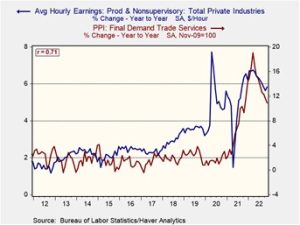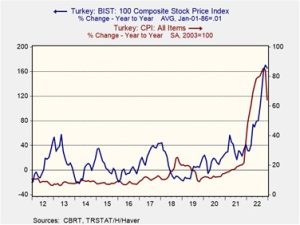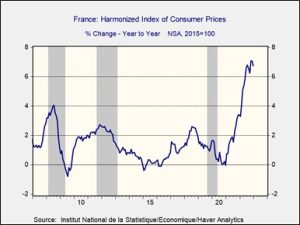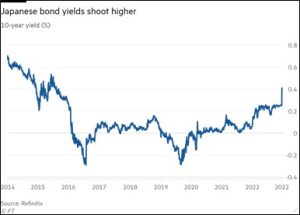by Patrick Fearon-Hernandez, CFA, and Thomas Wash
[Posted: 9:30 AM EST] | PDF
Our Comment today opens with the news of a potential mine shutdown that would affect global copper supplies and the increased tensions between China, Japan, and South Korea. We next review a wide range of other international and U.S. developments with the potential to affect the financial markets today, including signs that Pakistan is getting closer to defaulting on its foreign debts, and more indications that the Federal Reserve could soon slow its interest-rate hikes to just 25 basis points per meeting.
Global Copper Market: Canadian miner First Quantum Minerals Ltd. (FQVLF, $23.19) said that it will shut down its vast copper mine in Panama, which produces about 1.4% of the world’s copper supply, if it can’t resolve a tax dispute with the Panamanian government. Global copper prices remain in retreat, in large part because of the threat of recession in the West and lower demand from China as it deals with its latest COVID-19 wave. Nevertheless, any outage at the FQM mine could help put a floor under prices or even give them a boost.
China-Japan-South Korea: Today, the Chinese government suspended visa issuance to travelers from Japan and South Korea, marking its first formal retaliation for the COVID-19 testing rules those countries and others have imposed on travelers from China because of its massive new wave of infections.
- The move illustrates how willing China is to wield its massive economic power as a source of coercion or consensus-building to influence other countries’ behavior.
- As we wrote in our latest Bi-Weekly Geopolitical Report, published yesterday, China will probably grant or deny access to its vast market and capital flows in order to eventually establish a neo-colonial relationship with the countries in its evolving geopolitical bloc.
Russia-Ukraine War: After weeks in which the front lines from eastern to southern Ukraine were largely static, Russian forces have reportedly been able to capture most of the town of Soledar, just to the northeast of the embattled city of Bakhmut. That gives Russia a rare but mostly symbolic victory and will make it more difficult for Ukraine to hold Bakhmut, although the city isn’t expected to immediately fall. The Russian move also comes as reports indicate that the country’s government will soon announce the mobilization of 500,000 more troops in another special draft.
- Separately, after several countries last week agreed to send light tanks or armored vehicles to Ukraine, British officials said they have been discussing sending their Challenger 2 main battle tanks.
- Poland, Finland, and other European countries are also considering sending heavily armored, powerful tanks, which in sufficient numbers could provide a major boost to Ukraine’s military power.
Brazil: Following the weekend’s capital rioting by supporters of right-wing Former President Bolsonaro, the country’s supreme court yesterday ordered the suspension of the federal district’s governor, a Bolsonaro ally. The move is likely to further anger Bolsonaro’s supporters and could exacerbate the country’s political polarization. Separately, some Brazilian politicians who accuse Bolsonaro of inciting the unrest have demanded he be extradited from the U.S., where he has been for the last two weeks. Some prominent U.S. Democrats have echoed that call. However, the White House has merely said that it would treat any extradition request seriously.
Pakistan: Facing dwindling currency reserves and a high risk of default on its foreign debts, yesterday the Pakistani government begged the International Monetary Fund to ease the harsh conditions on its funding program for the country in order to unleash billions of dollars of additional loans. The IMF officials made no commitment to easing the terms.
Canada: The Canadian government announced yesterday that it will buy 88 advanced F-35 fighter jets from Lockheed Martin (LMT, $458.99) to modernize its air combat capabilities. The total cost of the purchase will be approximately $14 billion. The purchase illustrates how much the West’s increasing defense budgets and military modernization efforts are likely to benefit U.S. defense firms, given their cutting-edge technologies and production capacity.
U.S. Monetary Policy: San Francisco FRB President Daly said yesterday that because of the lags before changes in monetary policy affect the economy, it might make sense for the Fed to slow its interest-rate hikes to just 25 basis points beginning at its next policy meeting. According to Daly, that would give the policymakers more time to assess how their previous aggressive rate hikes are affecting economic activity. Meanwhile, Atlanta FRB President Bostic yesterday stated he would consider a 25-bps hike more seriously if Thursday’s inflation report shows that the consumer price index is slowing in line with other recent data releases. The statements place a spotlight on Fed Chairman Powell’s remarks later today when he may weigh in on the issue.
U.S. Student Loan Market: Today, the Department of Education released a proposed rule that would make it easier for student loan borrowers to use income-driven repayment plans and get out of their debt sooner. For example, the minimum amount of monthly discretionary income that would have to be paid on their loans would be cut to 5% from the current 10%. Borrower loan balances wouldn’t grow as long as they make their payments, which basically would amount to loan forgiveness for the borrowers with the lowest incomes.






